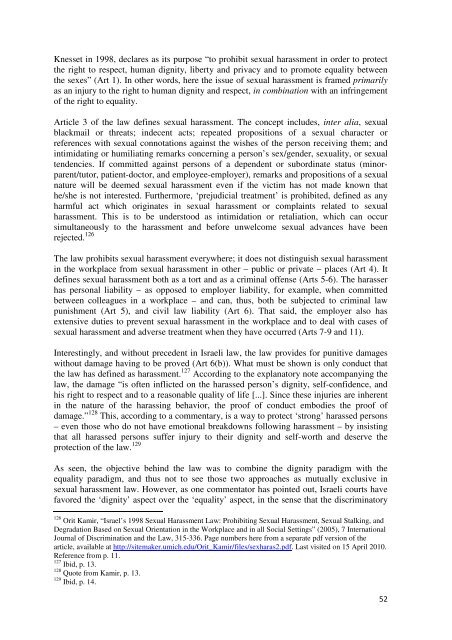Johanna Westeson - The ICHRP
Johanna Westeson - The ICHRP
Johanna Westeson - The ICHRP
Create successful ePaper yourself
Turn your PDF publications into a flip-book with our unique Google optimized e-Paper software.
Knesset in 1998, declares as its purpose “to prohibit sexual harassment in order to protect<br />
the right to respect, human dignity, liberty and privacy and to promote equality between<br />
the sexes” (Art 1). In other words, here the issue of sexual harassment is framed primarily<br />
as an injury to the right to human dignity and respect, in combination with an infringement<br />
of the right to equality.<br />
Article 3 of the law defines sexual harassment. <strong>The</strong> concept includes, inter alia, sexual<br />
blackmail or threats; indecent acts; repeated propositions of a sexual character or<br />
references with sexual connotations against the wishes of the person receiving them; and<br />
intimidating or humiliating remarks concerning a person’s sex/gender, sexuality, or sexual<br />
tendencies. If committed against persons of a dependent or subordinate status (minorparent/tutor,<br />
patient-doctor, and employee-employer), remarks and propositions of a sexual<br />
nature will be deemed sexual harassment even if the victim has not made known that<br />
he/she is not interested. Furthermore, ‘prejudicial treatment’ is prohibited, defined as any<br />
harmful act which originates in sexual harassment or complaints related to sexual<br />
harassment. This is to be understood as intimidation or retaliation, which can occur<br />
simultaneously to the harassment and before unwelcome sexual advances have been<br />
rejected. 126<br />
<strong>The</strong> law prohibits sexual harassment everywhere; it does not distinguish sexual harassment<br />
in the workplace from sexual harassment in other – public or private – places (Art 4). It<br />
defines sexual harassment both as a tort and as a criminal offense (Arts 5-6). <strong>The</strong> harasser<br />
has personal liability – as opposed to employer liability, for example, when committed<br />
between colleagues in a workplace – and can, thus, both be subjected to criminal law<br />
punishment (Art 5), and civil law liability (Art 6). That said, the employer also has<br />
extensive duties to prevent sexual harassment in the workplace and to deal with cases of<br />
sexual harassment and adverse treatment when they have occurred (Arts 7-9 and 11).<br />
Interestingly, and without precedent in Israeli law, the law provides for punitive damages<br />
without damage having to be proved (Art 6(b)). What must be shown is only conduct that<br />
the law has defined as harassment. 127 According to the explanatory note accompanying the<br />
law, the damage “is often inflicted on the harassed person’s dignity, self-confidence, and<br />
his right to respect and to a reasonable quality of life [...]. Since these injuries are inherent<br />
in the nature of the harassing behavior, the proof of conduct embodies the proof of<br />
damage.” 128 This, according to a commentary, is a way to protect ‘strong’ harassed persons<br />
– even those who do not have emotional breakdowns following harassment – by insisting<br />
that all harassed persons suffer injury to their dignity and self-worth and deserve the<br />
protection of the law. 129<br />
As seen, the objective behind the law was to combine the dignity paradigm with the<br />
equality paradigm, and thus not to see those two approaches as mutually exclusive in<br />
sexual harassment law. However, as one commentator has pointed out, Israeli courts have<br />
favored the ‘dignity’ aspect over the ‘equality’ aspect, in the sense that the discriminatory<br />
126 Orit Kamir, “Israel’s 1998 Sexual Harassment Law: Prohibiting Sexual Harassment, Sexual Stalking, and<br />
Degradation Based on Sexual Orientation in the Workplace and in all Social Settings” (2005), 7 International<br />
Journal of Discrimination and the Law, 315-336. Page numbers here from a separate pdf version of the<br />
article, available at http://sitemaker.umich.edu/Orit_Kamir/files/sexharas2.pdf. Last visited on 15 April 2010.<br />
Reference from p. 11.<br />
127 Ibid, p. 13.<br />
128 Quote from Kamir, p. 13.<br />
129 Ibid, p. 14.<br />
52
















